

Social Media To Be The Commonest Source Of CMEs. Social Media is the commonest use of Internet. Everyone uses the internet to access their emails and Facebook accounts. Doctors Use Social Media to Connect With Patients. Recent articles suggest that social media is finding a home among some doctors for creating better awareness and engagement among patients.
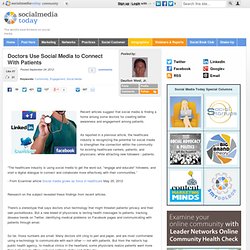
As reported in a previous article, the healthcare industry is recognizing the potential for social media to strengthen the connection within the community for existing healthcare centers, patients, and physicians, while attracting new followers / patients. Doctors tell how they use social media as professional watercooler. David May, MD, describes Twitter as a doctors’ lounge.
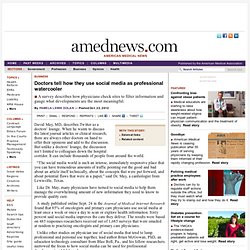
When he wants to discuss the latest journal articles or clinical research, there are always other doctors on hand to offer their opinions and add to the discussion. But unlike a doctors’ lounge, the discussion isn’t limited to colleagues down the hospital corridor. It can include thousands of people from around the world. “The social media world is such an intense, immediately responsive place that you can have tremendous amounts of traffic pointing out the good and bad about an article itself technically, about the concepts that were put forward, and about potential flaws that were in a paper,” said Dr. May, a cardiologist from Lewisville, Texas. Like Dr. Medical Schools Now Offering Social Media Training. Social media is now an essential component in the medial field, whether you’re searching for a job, connecting with patients or marketing your practice or product.
The impact social media now plays in the medical field is so great, four medical school are offering social media training to aspiring doctors. The schools, including Albert Einstein College of Medicine at Yeshiva University, are utilizing a two year grant from the Institute of Medicine as a Profession (IMAP) and the Josiah Macy Jr. Putting a gag on patients. Erica Cohen Posted: Wednesday, September 26, 2012, 5:05 PM by Erica Cohen.
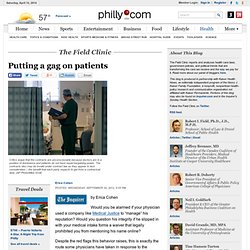
Best practices in HCSM. Patients worried about medical records going digital. It took some time to get a majority of physicians in the U.S. to agree that it would be beneficial to implement electronic health records in their practices.

Now, a survey finds, the most skeptical audience for EHRs is patients. A survey of more than 2,100 patients by Xerox found that only 26% want their medical records to be digital, down two percentage points from a year ago. Only 40% believe EHRs will result in better, more efficient care. And 85% expressed concern about digital records.
3 Mobile Strategies for Growing Hospital Market Share. If your organization is still dragging its feel with the mobile marketing game, you may unintentionally be alienating a large group of patients.
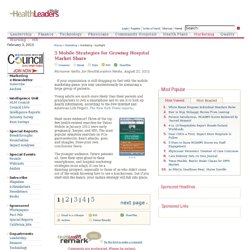
Young adults are much more likely than their parents and grandparents to own a smartphone and to use it to look up health information, according to the Pew Internet and American Life Project, The New York Times reports . Need more evidence? Three of the top five health-related searches for Yahoo Mobile in January 2012 were early pregnancy, herpes, and HIV.
The most popular symptom searches on PCs: gastroenteritis, heart attacks, gout, and shingles. Coming Next - Doctors Prescribing Apps to Patients. Best practices in HCSM. Why Are We Avoiding Our #Doctors? #hcsm #hcmktg. Top 10 iPhone medical apps for 2011. As the end of 2011 approaches, online marketplaces are publishing the usual flurry of year-end lists compiled from the best 2011 had to offer.
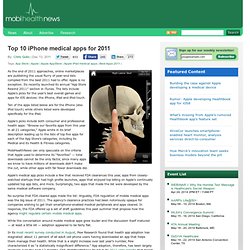
Apple is no exception. Its recently launched its annual “App Store Rewind 2011″ section in iTunes. The lists include Apple’s picks for the year’s best overall games and apps for iOS devices: the iPhone, iPad and iPod touch. Ten of the apps listed below are for the iPhone (also iPod touch) while others listed were developed specifically for the iPad.
Apple’s picks include both consumer and professional health apps: “Browse our favorite apps from this year in all 21 categories,” Apple wrote in its brief description leading up to the lists of top five apps for each of the App Store’s categories, including its Medical and its Health & Fitness categories. No surprise that FDA cleared apps made the list: Arguably, FDA regulation of mobile medical apps was the big issue of 2011. What Types of Health Care Activities Would Consumers Like To Do via Mobile Phone? - Data Points. Why health and medical apps should be certified. A draft of standards for a health and medical app certification program was released recently by Happtique.

As a matter of disclosure I am proud to have been the Chair of the panel that drafted these standards. The standards are in draft form and are open to public comment until August 17, 2012. While some might say that these standards add even more barriers to the commercial adoption of these technologies, there are substantial reasons for the need of such certification. 1. Consumers, patients, and healthcare providers want reliable, safe apps. Healthcare Social Media Best Practices #hcsmbp / The Future of Healthcare is Already at Your Fingertips #hcsmbp #newhouseprsm. 5 ways mobile apps streamline patient-doctor communication. Much has been said about today's mobile apps, whether it's their ability to empower the patient or create a more portable practice for physicians.

Yet, according to Michael Nusbaum, MD, founder of mobile application MedXCom, one of the most beneficial aspects of mobile applications could very well be better communication between doctor and patient. Nusbaum highlights five ways mobile applications are streamlining patient-doctor communication. 1. Secure messaging. According to Nusbaum, HIPAA-compliant, secure messaging from doctor to patient is possible through certain mobile apps. [See also: Mobile health advocates say meaningful use is part of their plan.] 2. Webicina. Medicine in Social Media. What Do Doctors And Scientists Need To Know About Social Media? #video.
Physician Reputations: What every Administrator and Doctor Should Know. Medicine, morality and health care social media. 2 tips to measure your hospital’s social media ROI. Find out if your social media strategy is working.
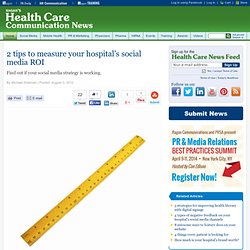
By Michael Sherman | Posted: August 3, 2012 Everyone seems to have a Facebook and Twitter account, both personally and for business. Behold! The finalists for PR and marketing awards in health care. By Lauren Yanow | Posted: July 31, 2012 Editor's note: This announcement is from Health Care Communication News, a sister site of PR Daily.
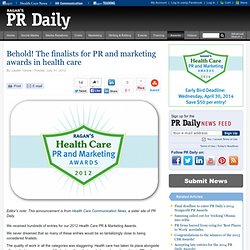
We received hundreds of entries for our 2012 Health Care PR & Marketing Awards. We never dreamed that so many of these entries would be so tantalizingly close to being considered finalists. The quality of work in all the categories was staggering. Health care has taken its place alongside other industries as a source of first-rate writing, design, photography and graphics in PR and marketing. The Benefit of Healthcare Online Communities. July 25, 2012 • By Jean Kelso Sandlin, EdD, Senior Strategist flickr: kaybee07 Recently, when reading an article by Chelsea Lonsdale in the Slughorne Journal titled The “Intimate Public” of Mommy Blogs , I was reminded of the concept of “the intimate public” first introduced by Lauren Berlant.
It’s a helpful concept as you consider how online communities can be used to prevent or manage illness, as well as how to extend the benefit of these online communities to offline patients. Lonsdale borrowed the phrase “intimate public” from Lauren Berlant’s book The Female Complaint (2008) and related Berlant’s definition of intimate public: “a porous, affective scene of identification among strangers that promises a certain experience of belonging and provides a complex of consolation, confirmation, discipline, and discussion about how to live as an x.”
A valuable patient service. Infographics - Health / How healthcare professionals use social media [infographic] #SXSH #SocPharm #hcsm. The High Cost of HIPAA Violations [Infographic] Security breaches have increased over 32% over the past year in healthcare organizations costing an estimated 6.5 billion dollars annually according to a study by the Ponemon Institute. Best Practices Of Social Media Usage In Healthcare. Why computers can never replace physicians as diagnosticians. Hospital Networks Take Key Role in Health Care as IT Makes Further Clincial Advances. The health care industry's increased use of electronic medical records (EMRs), wireless medical devices and personal mobile technology has turned hospital networks into important components in patient treatment. Practicing medicine now requires maintaining constant wireless connectivity and possibly managing wired network traffic if doctors and nurses are to fully leverage health IT according to health care professionals.
Healthcare Technology.